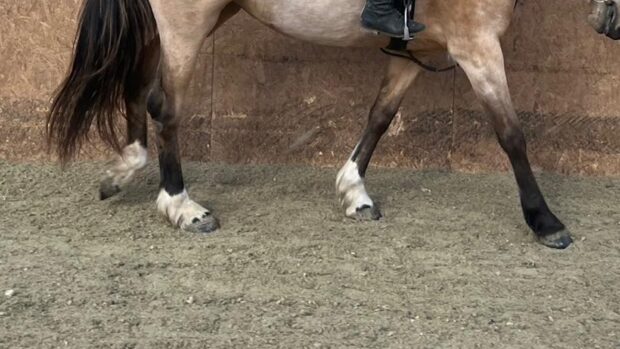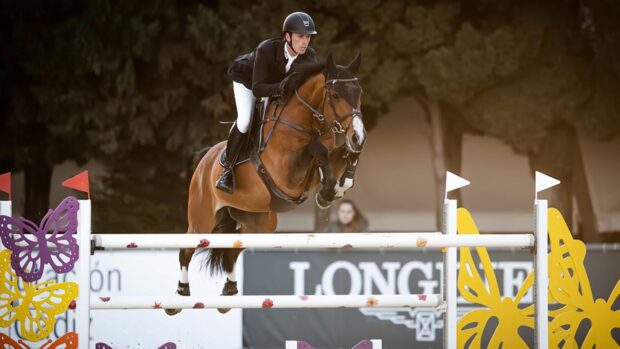When Armageddon struck a tendon while point-to-pointing, his owners feared the worst. But an unusual love of being indoors and a strict management programme boosted his chances and, against the odds, he returned to ridden work. Aimi Clark documents her horse’s extraordinary recovery
Sunday 30 May 2010
Armageddon (“Arnie”), the first point-to-pointer owned and trained by my family, is being bathed and plaited ready for the men’s open at tomorrow’s South Tetcott Hunt point-to-point. This is no easy task; he fidgets and kicks out because he hates fuss. We bought Arnie from Ascot Sales in March 2008, and tomorrow will be his last race before retiring to the hunting field. He is 12 now, and we have had a lot of fun with him.
Monday 31 May 2010
Everyone on the yard is excited; this is our local point-to-point and my family is involved with its organisation, so to have a horse running there is particularly special. Arnie knows it’s raceday; it takes three of us to get his travel boots on and he charges up the ramp. We have learnt to be ready to drive straight out of the yard in order to stop him kicking at the sides.
It takes 20 minutes to drive to Upcott Cross and the venue is buzzing. As soon as I park, banging starts in the back of the lorry. We have timed it so that we don’t have too much waiting to do and Arnie is off the lorry by the time his jockey, Mike Heard, comes to saddle up. Despite all the fidgeting and kicking, once I lead Arnie to the paddock he is as quiet as a mouse — he just likes to get on with the job. There are four horses in the race and at 17.2hh Arnie is the tallest. The going is good and we are hopeful of a solid race. When the jockeys appear, Mike is given a leg-up and follows the rest down to the start. As I let him go, I give Arnie a pat and wish them both good luck.
Disaster strikes
We never pile pressure on our horse to win. Instructions are to listen to him and have a good race, something Mike always does. The field sets off at a decent pace and Arnie is galloping and jumping confidently. It’s not easy watching for my family — we love this horse and that makes us nervous spectators — but it is exciting. It’s a close race and two laps down, Arnie is right up there with the leader. However, our worst fears are realised early in the final lap when, at the fence right in front of us, Arnie takes a funny step in front of it and lands on three legs.
Immediately Mike pulls up. We run to him and see that Arnie’s left-fore fetlock is touching the ground. It’s a horrible sight. Adrenaline is still pumping and Arnie doesn’t want to stand still, so we lead him to the lorry.
Our vet, David Rowlands from Penbode Equine, was by the fence and saw it happen. He meets us at the lorry. Various friends are called on to get ice from the bar; another fetches extra water. David removes Arnie’s boots — he always races in Dalmar racing boots, which have carbon-fibre strike protection. He says that Arnie struck into himself and has injured his tendon. We won’t know how badly until the swelling has had a chance to subside and a scan can be done in a few days’ time.
For now, David applies ice to the leg to help with the swelling and bruising and straps it up to support the tendon while he travels home. It resembles the cast that people wear when they break a leg. Arnie has calmed and the pain is starting to kick in. He is given intravenous painkillers and we have strict instructions to give him medicine in his feed this evening, too.
When we get home we start icing the leg every 20 minutes. We keep the other front leg bandaged too. During the afternoon and night we take it in turns to do Arnie’s leg. There is a risk of colic due to the stress.
Tuesday 1 June 2010
I have never been in this position before. Arnie is at peak fitness but unable to leave his stable. Last night we discussed whether we should have him put to sleep. David has made it clear that Arnie might not recover, and he is unlikely to ever be ridden again. We decide to wait and see what the scan tells us.
Arnie is still relaxed this morning and he has eaten and drunk as normal, even with medicine in his feed. But in the afternoon we hear a commotion in his stable — he is colicking and kicking out with his injured leg. David comes straight out and does a full examination. He determines that leg pain is the cause, and warns us that Arnie might keep doing this. We check him throughout the night and, thankfully, the medication works.
Wednesday 2 June 2010
Arnie is very quiet this morning and lying down. He needs to have an injection every day to help with the pain. As we are a farming family, we are allowed to do this ourselves. However, we can’t give him any in his flanks because he kicks out, so we alternate which side of his neck we put the needle in.
Friday 4 June 2010
Arnie is tolerating his box rest remarkably well. He has a new window in the back of his stable so now he has two views, which he seems to like. He lies down a lot, which is unusual and means his leg is hurting. He gets upset when others go hacking without him, but some chaff keeps him occupied.
David visits to scan Arnie’s leg and confirms that he has severed the tendon, and it is hanging together by a few strands. We conclude that the only reason Arnie stayed on his feet was because the boots softened the blow. Now it’s crunch time.
David explains that a lot of horses would be put to sleep with this injury, but if Arnie is a good patient and can cope with six months’ box rest, he has got a chance of recovering well enough to live a comfortable life. Our hearts rule our heads and we decide to give him a chance. We own horses with whom we wouldn’t attempt this, because box rest would drive them crazy, but we believe that Arnie’s love of being indoors could be his trump card.
The rest of June
David and his colleague Gemma Hearn visit regularly, and we suffer two setbacks. The first is a sore on the healthy leg, which we have bandaged to support it while it bears the majority of Arnie’s weight. He is a big 17.2hh thoroughbred, and we’re aware that his size and weight could work against him. Now we have no choice but to leave the healthy leg unbandaged.
The second setback occurs when Gemma visits to give Arnie an injection. He becomes uncomfortable and colicky, kicking at his bed with his injured leg. Gemma stays on the yard until he settles again, thankfully without more veterinary intervention. The next time Arnie is jabbed we are nervous, but there is no more drama.
July 2010
Because Arnie has not been able to bear weight, his feet haven’t been shod. Worried that this will put unwanted pressure on his tendon, our farrier visits. It’s not a quick process as Arnie can’t stand on his injured leg for long, nor lift the other foreleg very high.
My dad pushes against Arnie’s shoulder so that he can take some of the weight. We also have to be careful with the soles of his feet. Arnie needs a thick bed at all times so that he can lie down if he wants, but this risks thrush. Although his soles do soften, thankfully good management means it never becomes an issue. He wears a flysheet in his stable to stop him kicking at flies and stamping his feet.
August 2010
Three months on and Arnie still hasn’t left his stable. His box in the corner of the yard has a good view of the whole farm, and the second window we added at the back of his stable is doing its job. Every morning Arnie watches the house waiting for us to come out. We can also see into his stable from indoors. My mum isn’t horsey, but she sneaks him a carrot every time she goes out. This makes Arnie happy!
September-October 2010
Arnie is no longer being bandaged during the day, but he is at night. He is moving around his stable comfortably and he has been off his medicine for a while. A second scan shows improvement in the leg, so we begin to hope.
November 2010
David feels the tendon is strong enough for Arnie to leave his stable. We begin by tying him up outside while we muck out and groom. The next step is to let him loose in our yard, which is approximately 15x15m and means he can’t get up any speed. First time out Arnie leaps into the air but, luckily, that’s it. We let him spend as much time as possible loose in the yard.
December 2010- March 2011
We start leading Arnie in-hand around the main yard. We are cautious and he is bandaged, with Dalmar boots on top, and we slowly build up how much he does. His favourite route is going into the garden to graze.
April 2011
With the OK from David we turn Arnie out in a small 20x20m paddock. He leaps and bucks, before he puts his head down to eat. He is never left unattended and after a week of monitored turnout he is allowed into a bigger paddock with one of our veterans for company. For our peace of mind we bandage him each time, and he still prefers to come in at night.
May 2011
Due to mounting vet bills, we have chosen not to have the leg scanned again. Arnie is happy and sound in the field, so he will have the rest of the summer to strengthen. Whenever David or Gemma visits another horse, they assess Arnie’s leg and remark how strong it feels. A white patch has developed on the point he struck into, and the tendon is noticeably bigger than the other. He is wearing shoes in front again to prevent sore feet.
January 2012
Arnie spends the rest of 2011 out of work, but he is sound and happy. He trots and canters around the field confidently, and we start talking about riding him again. We build up to the ride by tacking him up and leading him around the yard for a few days beforehand. After all, it’s nearly two years since he had a saddle on.
Dad volunteers to ride first and Arnie strolls out like he’s never been away. Unsurprisingly he tires quickly and we only do a short loop in walk. Dad starts taking him out on a regular basis, building his fitness slowly until he is walking for an hour. Four weeks in, we box up and take Arnie to a different bridleway. He is very excited and marches ahead of the two fit thoroughbreds my sister and I are riding! It is a great sight.
The rest of 2012
Dad entertains the idea of hunting Arnie again. However, in the end we decide not to risk it. The following year we retire Arnie at the age of 16. He still lives with us today, roaming a large yard at his leisure but still hiding in a stable when it rains. His injured tendon is barely noticeable, and his leg has never given him any problems. We’re very happy we gave Arnie a second chance.




